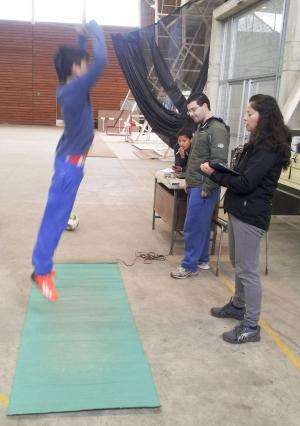Plyometric training can lead to a significant increase in the physical performance of sportspeople

Rodrigo Ramírez-Campillo, lecturer in physical education and PhD holder in health sciences, has shown in his PhD thesis how plyometric training —exercises involving jumping, sprinting and throwing— done by young football players can significantly increase their physical performance and thus, potentially, their competitive performance as well.
During his research, carried out at the NUP/UPNA-Public University of Navarre, he conducted five studies on 361 participants: four on male football players between the ages of 10 and 17, one on distance and middle-distance runners, adult men and women.
The PhD thesis sought to analyse how effective this type of training is in the physical improvement of sportspeople, bearing in mind also variables like rest times, training frequency and the surface on which this is done. "Unlike other exercises," explained Rodrigo Ramírez, "plyometric exercises don't need a lot of equipment, space and time, so they have great practical efficiency within the training plan of sportspeople."
Plyometric exercises may involve jumping, throwing, short sprints and other similar movements, although jumping is the most used. The participants in this study had to do descending jumps (allowing themselves to fall from a 20-60 cm box and then immediately jump as high and as quickly as possible), repeated horizontal and vertical hopping and jumping (several jumps in succession without resting), and interrupted jumps (with breaks between them) with their various combinations.
The thesis by Rodrígo Ramírez is entitled "Efectos del entrenamiento pliométrico sobre el rendimiento explosivo y aeróbico. Influencia del periodo de descanso, el volumen y la superficie" [Effects of plyometric training on explosive and aerobic performance. Influence of rest periods, volume and surface].
The plyometric method is used mainly to train young and adult sportspeople; it involves a minimum level of motor skills to ensure the exercises are done properly and safely. It can be applied to sportspeople who compete in contests involving speed, strength, stamina, etc. Some pieces of research have shown that older adults were able to improve their muscle power through exercises of this type.
Novel results
In the course of the research it was shown that young football players can carry out plyometric training sessions on consecutive days, and their performance can improve considerably in this way. "This means a significant paradigm shift, since traditionally it used to be suggested that a break of at least 48 hours would be needed between one session and the next," as the author of the research pointed out.
One of the most interesting results had to do with the volume of training; in other words, with the number of repetitions that need to be carried out to achieve an improvement in performance. "It is commonly believed that more means better, but the results showed that this is not the case in plyometric training. We saw that a moderate volume of jumping repetitions (60 per session) was significantly more efficient that a high volume (120 per session)."
Another discovery is linked to the resting time that needs to be taken between one set of exercises and another. A break of at least 2 minutes used to be recommended always, but there was little scientific evidence to support this practice. In this study, breaks of 2 minutes, 1 minute or 30 seconds were carried out. "Surprisingly the three breaks turned out to be equally effective when it came to improving the performance of young football players. This suggests important practical applications, since a 30-second break would allow a shorter physical training session, and that way the rest of the time could be devoted to technical and tactical training." In this respect, Rodrigo Ramírez considers that plyometric training should not take longer than 20 to 30 minutes.
Finally, as regards the type of surface on which the training is done, it was found that a hard surface (wooden) offered relatively greater advantages than a soft one (mat), without causing major muscle stiffness or injuries. In this respect, "a certain specificity of training was observed; the results suggest that plyometric training should ideally be done on the surface on which the sportspeople compete; in this case, grass."
More information: Ramírez-Campillo R, Meylan CM, Alvarez-Lepín C, Henriquez-Olguín C, Martinez C, Andrade DC, Castro-Sepúlveda M, Burgos C, Baez EI, Izquierdo M. 2013. The effects of interday rest on adaptation to 6-weeks of plyometric training in young soccer players. Journal of Strength and Conditioning Research. www.ncbi.nlm.nih.gov/pubmed/24149758
Ramírez-Campillo R, Alvarez C, Henríquez-Olguín C, Baez EB, Martínez C, Andrade DC, Izquierdo M. 2014 Effects of plyometric training on endurance and explosive strength performance in competitive middle- and long-distance runners. Journal of Strength and Conditioning Research, 28(1):97-104. www.ncbi.nlm.nih.gov/pubmed/23838975
Ramírez-Campillo R, Andrade DC, Izquierdo M. 2013. Effects of plyometric training volume and training surface on explosive strength. Journal of Strength and Conditioning Research 27(10):2714-22.
www.ncbi.nlm.nih.gov/pubmed/23254550
















